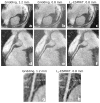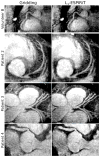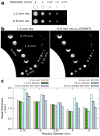High-resolution variable-density 3D cones coronary MRA
- PMID: 26172829
- PMCID: PMC4545694
- DOI: 10.1002/mrm.25803
High-resolution variable-density 3D cones coronary MRA
Abstract
Purpose: To improve the spatial/temporal resolution of whole-heart coronary MR angiography by developing a variable-density (VD) 3D cones acquisition suitable for image reconstruction with parallel imaging and compressed sensing techniques.
Methods: A VD 3D cones trajectory design incorporates both radial and spiral trajectory undersampling techniques to achieve higher resolution. This design is used to generate a VD 3D cones trajectory with 0.8 mm/66 ms isotropic spatial/temporal resolution, using a similar number of readouts as our previous fully sampled cones trajectory (1.2 mm/100 ms). Scans of volunteers and patients are performed to evaluate the performance of the VD trajectory, using non-Cartesian L1 -ESPIRiT for high-resolution image reconstruction.
Results: With gridding reconstruction, the high-resolution scans experience an expected drop in signal-to-noise and contrast-to-noise ratios, but with L1 -ESPIRiT, the apparent noise is substantially reduced. Compared with 1.2 mm images, in each volunteer, the L1 -ESPIRiT 0.8 mm images exhibit higher vessel sharpness values in the right and left anterior descending arteries.
Conclusion: Coronary MR angiography with isotropic submillimeter spatial resolution and high temporal resolution can be performed with VD 3D cones to improve the depiction of coronary arteries.
Keywords: 3D cones; coronary imaging; parallel imaging; trajectory design.
© 2015 Wiley Periodicals, Inc.
Figures







References
-
- Mendis S, Puska P, Norrving B, editors. Global atlas on cardiovascular disease prevention and control. World Health Organization; Geneva: 2011.
-
- Rochitte CE, George RT, Chen MY, Arbab-Zadeh A, Dewey M, Miller JM, Niinuma H, Yoshioka K, Kitagawa K, Nakamori S, Laham R, Vavere AL, Cerci RJ, Mehra VC, Nomura C, Kofoed KF, Jinzaki M, Kuribayashi S, de Roos A, Laule M, Tan SY, Hoe J, Paul N, Rybicki FJ, Brinker JA, Arai AE, Cox C, Clouse ME, Di Carli MF, Lima JAC. Computed tomography angiography and perfusion to assess coronary artery stenosis causing perfusion defects by single photon emission computed tomography: the CORE320 study. European Heart Journal. 2014;35:1120–1130. - PMC - PubMed
-
- Hoffmann U, Ferencik M, Cury RC, Pena AJ. Coronary CT angiography. Journal of Nuclear Medicine. 2006;47:797–806. - PubMed
-
- Sakuma H, Ichikawa Y, Chino S, Hirano T, Makino K, Takeda K. Detection of coronary artery stenosis with whole-heart coronary magnetic resonance angiography. J Am Coll Cardiol. 2006;48:1946–1950. - PubMed
Publication types
MeSH terms
Grants and funding
LinkOut - more resources
Full Text Sources
Other Literature Sources

